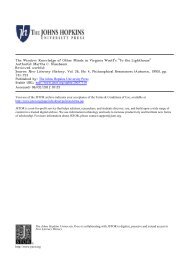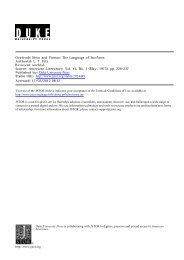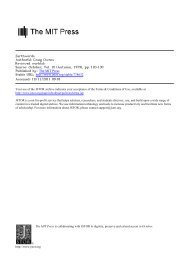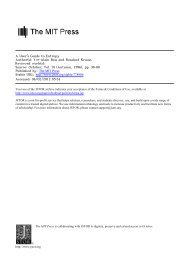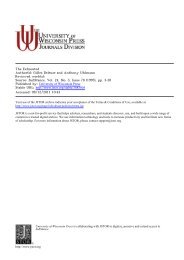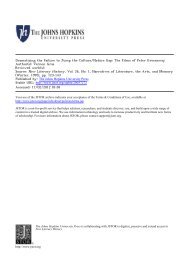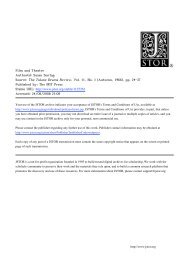Krauss-LeWitt in Progress - engl328
Krauss-LeWitt in Progress - engl328
Krauss-LeWitt in Progress - engl328
Create successful ePaper yourself
Turn your PDF publications into a flip-book with our unique Google optimized e-Paper software.
48<br />
OCTOBER<br />
pursuit of <strong>in</strong>telligibility by mathematical means. This tradition is profoundly<br />
humanistic <strong>in</strong> import, for it <strong>in</strong>volves the deification of the human m<strong>in</strong>d by reason<br />
of its mathematical prowess."<br />
The specific work <strong>in</strong> which Kuspit sees this deification of the human m<strong>in</strong>d <strong>in</strong><br />
operation is called Variations of Incomplete Open Cubes (1974). It is a modular<br />
structure composed of 122 units, each a member of a f<strong>in</strong>ite series, the series ordered<br />
<strong>in</strong> terms of a numerical progression. Throughout the series the "cube" as such is<br />
given only <strong>in</strong>ferentially, <strong>in</strong>itially by provid<strong>in</strong>g the least possible <strong>in</strong>formation<br />
(three edges set perpendicular to one another), and then progressively supply<strong>in</strong>g<br />
more of the miss<strong>in</strong>g edges, end<strong>in</strong>g with the greatest possible <strong>in</strong>formation (eleven<br />
edges). Each of the modules <strong>in</strong> the series is eight <strong>in</strong>ches on a side; each is pa<strong>in</strong>ted<br />
white; and the 122 skeletal structures are assembled on a vast platform.<br />
"The viewer," Kuspit <strong>in</strong>forms us, "completed the <strong>in</strong>complete cubes by<br />
mentally supply<strong>in</strong>g the miss<strong>in</strong>g edges, and experienced the tension between the<br />
literally unf<strong>in</strong>ished and the mentally f<strong>in</strong>ished cubes-between what Kant would<br />
call the phenomenal cube and the idea of the cube."2<br />
For almost no writer who deals with <strong>LeWitt</strong> is there any question that these<br />
geometric emblems are the illustration of M<strong>in</strong>d, the demonstration of rationalism<br />
itself. "At times," one critic writes, "the most elaborate of these constructions<br />
resemble translations of complete philosophical systems <strong>in</strong>to a purely formal<br />
language. If anyone could perceive the structural beauty of, say, Descartes's or<br />
Kant's treatises and then go on to recreate them as exclusively visual metaphor, it<br />
is surely <strong>LeWitt</strong>."3<br />
There may of course be readers of this k<strong>in</strong>d of criticism who balk at<br />
statements of this sort. They may f<strong>in</strong>d it strange that <strong>in</strong> the last quarter of the<br />
twentieth century there should have arisen an art dedicated to a triumphant<br />
Cartesianism, that when almost everyth<strong>in</strong>g else <strong>in</strong> our cultural experience has<br />
<strong>in</strong>structed us about the necessity of abandonn<strong>in</strong>g the fantasy of the transcendental<br />
subject, <strong>LeWitt</strong> should be capable of reassur<strong>in</strong>g us about its powers.<br />
For if I see myself putt<strong>in</strong>g to sea, and the long hours without landfall, I<br />
do not see the return, the toss<strong>in</strong>g on the breakers, and I do not hear the<br />
frail keel grat<strong>in</strong>g on the shore. I took advantage of be<strong>in</strong>g at the seaside<br />
to lay <strong>in</strong> a store of suck<strong>in</strong>g-stones. They were pebbles but I call them<br />
stones. Yes, on this occasion I laid <strong>in</strong> a considerable store. I distributed<br />
them equally among my four pockets, and sucked them turn and turn<br />
about.4<br />
But the power of human reason has captured the imag<strong>in</strong>ation of a number of<br />
contemporary writers on art, for whom abstraction is necessarily the outcome of<br />
1. Donald Kuspit, "Sol <strong>LeWitt</strong>: The Look of Thought," Art <strong>in</strong> America, LXIII (September-<br />
October 1975), 48.<br />
2. Ibid., p. 43.<br />
3. Robert Rosenblum, <strong>in</strong> Sol <strong>LeWitt</strong>, New York, The Museum of Modern Art, p. 14.<br />
4. Samuel Beckett, Molloy, New York, Grove Press, 1965, p. 69. All subsequent extracted passages<br />
appear on pp. 69-72.



